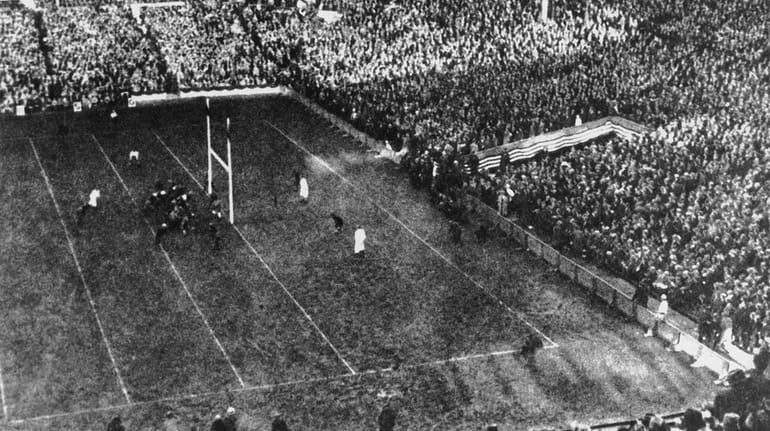Giants owner Wellington Mara's marquee game against Chicago Bears saved football in New York

The Polo Grounds with more than 70,000 fans and 125 reporters to see the Giants play Red Grange and the Chicago Bears, Dec. 6, 1925. Credit: AP/Pro Football Hall of Fame
It’s a situation that would have seemed absurd a year ago and abnormal at the beginning of this season but has become all too commonplace now.
When the Giants host their next home game, scheduled for Dec. 13 against the Cardinals at MetLife Stadium, there will be no fans in the building. Coronavirus precautions have eliminated in-person spectators from many NFL venues, and while some teams have welcomed in fractional crowds, the Giants played to an entirely empty house in each of their five previous home games this season and will continue to for the final three.
Had that been anything close to the case exactly 95 years ago on Sunday, when the Giants hosted the Bears, there is a good chance none of the current games would not be taking place.
That’s because on Dec. 6, 1925, toward the end of the Giants’ inaugural season, with the franchise bleeding money and owner Tim Mara and other NFL executives worried that professional football might never be a success in New York City, more than 70,000 fans packed the Polo Grounds in upper Manhattan.
Sure, they came not to see the Giants so much as to witness Red Grange play for the visiting team, but their attendance and their money counted just the same.
The Giants lost that game, 19-7, but it was the day that proved to Mara that the team he bought with a $500 investment could survive in America’s largest market.
"That game in the Polo Grounds literally saved the marquee franchise who had just joined the league," Joe Horrigan, the recently retired executive director of the Pro Football Hall of Fame and one of the sport’s premier historians, told Newsday. "[Mara] was a businessman and he didn’t want to waste his money. The Grange Game took his red ink and turned it black."
In the fall of 1925, before the Giants had even played a game, Mara knew that Grange was the key to financial success. The Galloping Ghost was one of the biggest names in sport as a star at the University of Illinois at a time when the popularity of the college game dwarfed that of the pro level. If Mara could sign Grange and bring him to New York, he’d have the star he knew he needed to kick-start the franchise.
He’d tried to do that with Jim Thorpe, the earliest splash signing for the team, but he already was washed up at the age of 38 and lasted just three games in a Giants uniform. Grange was young, handsome and titillating. Having his name on the marquee for Giants games would have done for them what Babe Ruth did for the Yankees.
So off to the Midwest went Mara on a quest for his star. While in Chicago trying to sign Grange, he sent a strange telegram back home.
"Partially successful," he wrote. "Returning on train tomorrow. Will explain."
No one with the Giants knew what it meant until Mara stepped off that train with the bad news that he had failed to land his prey. Grange decided to remain close to home and signed with George Halas and the Bears before Mara even arrived in town to make his case. But Mara returned to New York with the next-best thing.
He had gotten Halas to agree to play the Giants in New York.
"Grange will be playing in the Polo Grounds this year," Mara said, "only he’ll be playing for the Bears."
When that finally happened, Grange, who had played the day before the Giants game in Frankford, was used sparingly but still had a decent day. He gained 128 yards passing, rushing, receiving and returning.
Off the field, he did even better. He earned about $30,000 from his share of the gate receipts (that contract he signed with Halas and not the Giants gave him his own cut of the profits from home and road games) and, while in New York, secured thousands more in lucrative endorsement contracts. He even agreed to a movie deal that paid him about $300,000. That’s nearly $4.5 million in today’s dollars.
Mara desperately needed some of that star power because by the time Dec. 6 rolled around, he already was $40,000 in debt. The game was such a success, though, that the Giants cleared about $143,000 from the gate (after they paid Grange). By the end of the season, they had turned a small profit of about $18,000, enough to keep Mara and the Giants in the sport.
Besides saving the Giants, the game trumpeted the arrival of a new NFL, which had been formed just five years earlier. The 70,000 fans (plus a few thousand others who reportedly snuck in) were double the previous record for spectators at a pro football game. That mark had been set weeks earlier when Grange, having just finished his collegiate career, made his pro debut for the Bears in front of 36,000 at Wrigley Field.
The Dec. 6 game also drew something that was just as valuable: Exposure. More newspapers sent reporters to the Polo Grounds that day than for any other game in the league’s early history. It even garnered international attention, with the London Times reporting on the spectacle.
All of which meant that the teams that originally formed the NFL and had the earliest success in the league — teams such as the Canton Bulldogs, Akron Pros and Columbus Panhandlers — could no longer compete. Those small towns that were at first the heart of the NFL had to give way to the franchises in the big cities.
By 1927, a season after the Giants-Bears game in New York, Canton, Akron and Columbus had folded and within the next few years almost all of the charter teams either dissolved or moved to much larger markets. Only the Bears (known in 1920 as the Decatur Staleys) and Cardinals survive as original NFL teams. The Packers joined in 1921. The Giants, established in 1925, are the fourth-oldest current NFL franchise.
"It’s not just the most important early game in Giants history, but probably in NFL history," Horrigan said. "It gave the league credibility and the understanding of how fast this thing called the NFL was coming down the track."
It’s hardly slowed down, pushing through eras of expansion that included the introduction of playoffs in the 1930s, the Super Bowl age that began in 1967 and the merger with the AFL in 1970, right up to today’s version that sits atop the American sports pantheon.
Of course, there is tremendous irony that on the anniversary of a day when fans showed up to save the Giants, there will be none in attendance as they face the Seahawks in Seattle, and no one will come through a turnstile next week when the Giants host the Cardinals, one of the NFL’s original teams.
While it undoubtedly is a financial hit on owners of NFL teams — such as the Maras, who still own 50% of the Giants — much of the money to keep the league afloat no longer comes from the fickle gate, as it did in 1925, but from the lucrative contracts the league has with television networks.
"It makes you appreciate how important that game was in 1925," Horrigan said. "The success of the league today is that you can play a game and not have fans in the stadium. That’s how far we have come in 95 years."
And although they won’t physically be there, exponentially more than 70,000 people will be able to watch the Giants face the Seahawks on Sunday and the Cardinals next week . . . but only because those 70,000 in 1925 showed up when they did.

